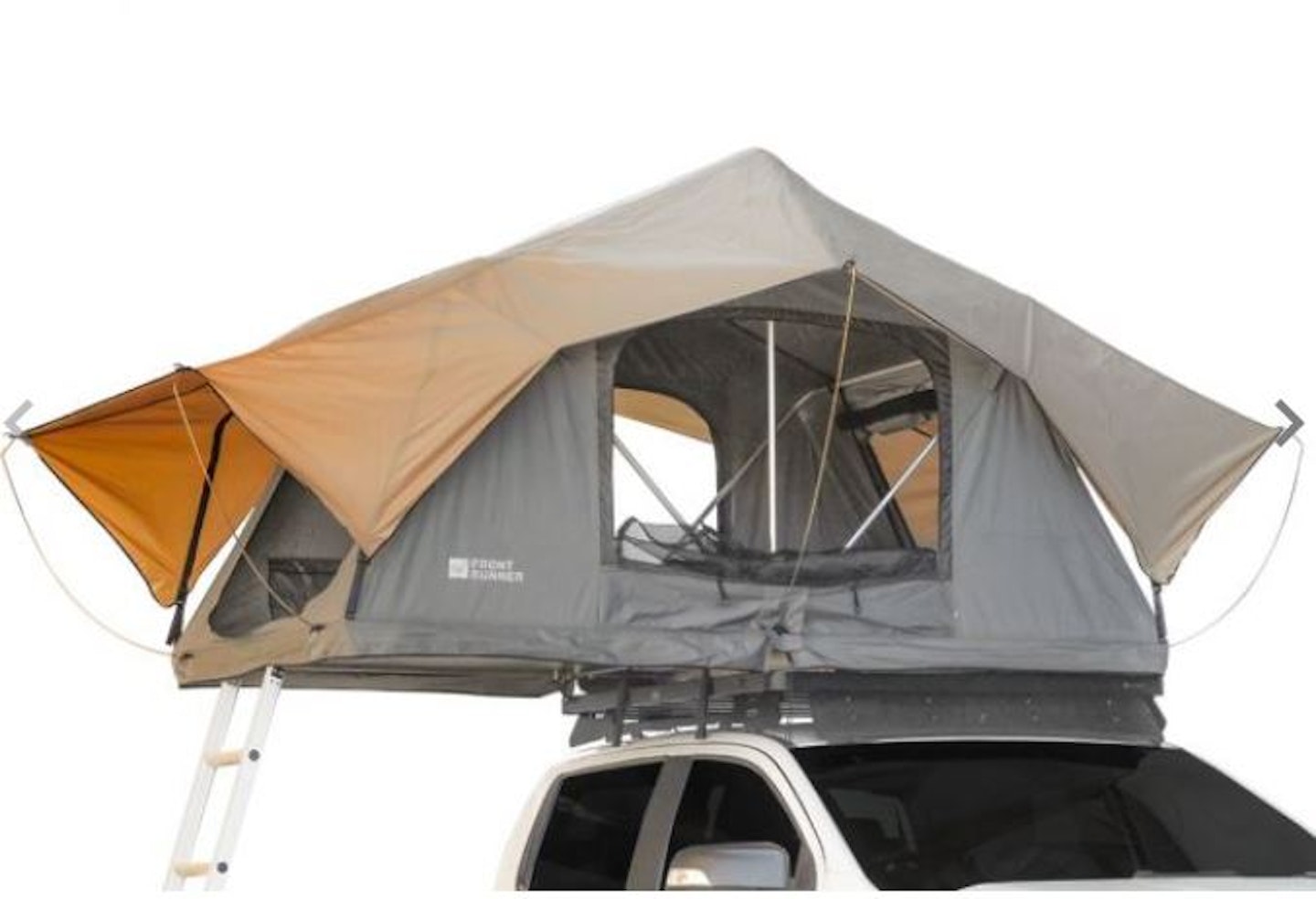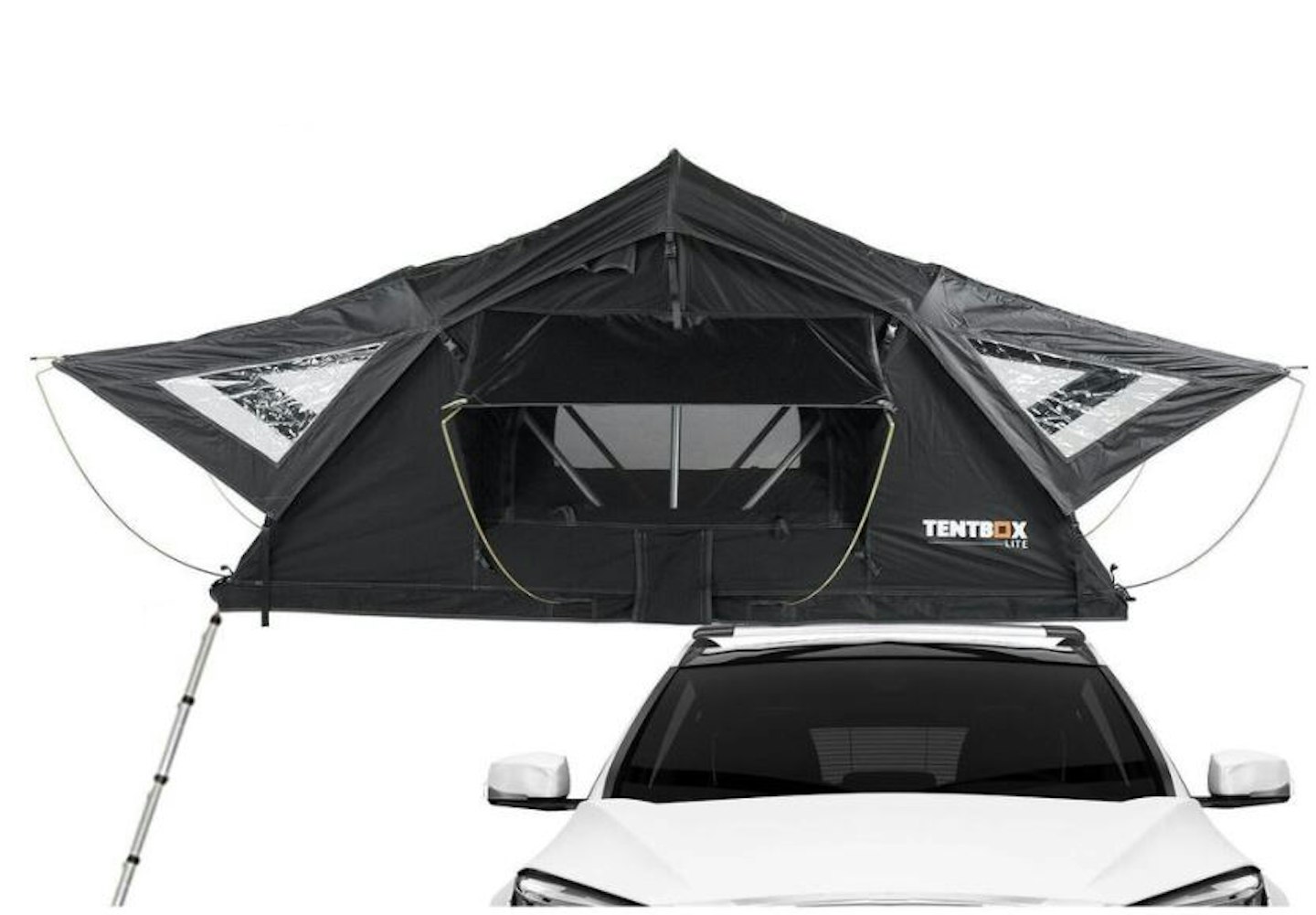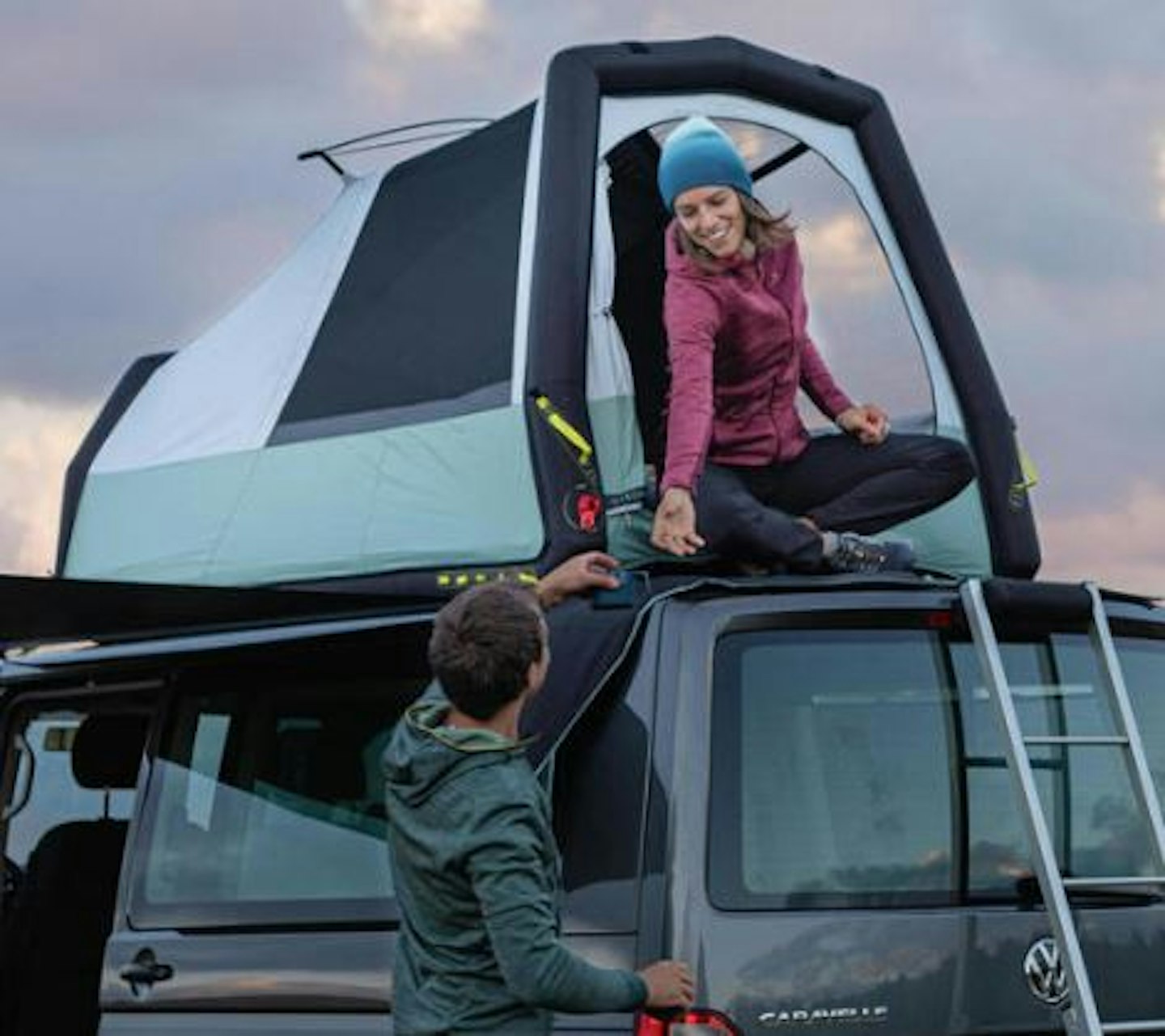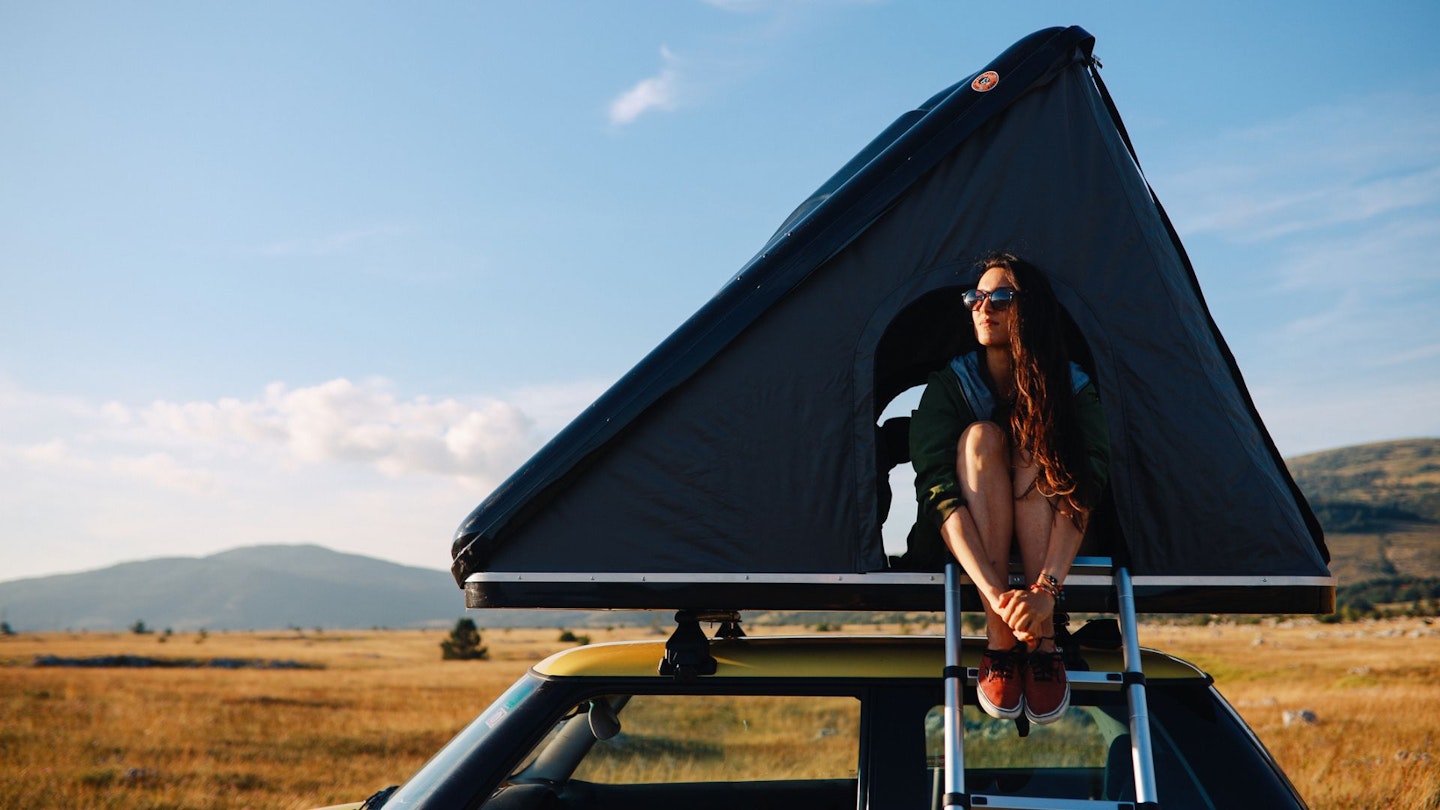Beyond the realm of sponsored Instagram people basking in their travel stories, rooftop tents are a very good idea for many campers.
Why use a rooftop tent instead of a regular one?
You'll note there is a considerable price difference between regular tents and rooftop tents. This comes down to design. A standard tent requires durable waterproof fabric, some zips, and some poles, and while models vary considerably but that is the baseline. Rooftop tents need tougher fabric to cope with the stress of road speeds and grit, in addition to UV and rain. Some rooftop tents even employ the use of hardshell materials for extra durability and improved aerodynamics.
Rooftop tents also need extra parts, such as fixings for roof racks, and many use gas struts instead of poles for fast pitching. It all adds to durability and practicality but means rooftop tents cost more than regular tents of equivalent size. However, they're still much more affordable than a campervan.
Rooftop tents are much faster to pitch than a regular tent, and because they're up off the ground, can also be a more attractive accommodation option in the winter months. During frosty weeks, views are spectacular, but temperatures aren't exactly jolly - pack a decent sleeping bag.
Who is a rooftop tent for?
In terms of capacity, one or two people, as rooftop tents offer similar space to a two-person tent. They're not super spacious, but they are highly practical and very comfortable for sleeping in at any time of year.
This type of tent isn't meant for long stays in one place, but more for the grand traveller and weekend-camper. They suit the former because you can pinball from place to place and set up camp within minutes. They suit the latter because the quick setup makes them easy to take away for a short trip too.
Rooftop tents also suit keen day hikers. With a rooftop tent back at base, people can embark on isolated and exciting day treks without having to carry all the sleeping equipment they would need if trying to access more remote walks on foot.
The best rooftop tents
Editor's pick

www.decathlon.co.uk
A hardshell model is more expensive than those without, but the improvements to durability and aerodynamics are dramatic. The best of these hardshell rooftop tents is the TentBox Classic.
The Classic is very thin when folded down, just 27cm, and looks very sleek with its ABS hardhat. The walls of the Classic are durable canvas, with silicone-taped seams and sealed zips. We also like the skeleton of this tent. It has an aluminium frame and stainless steel hinges and fixings. Therefore, it's stable when windy but also highly resistant to weathering.
Inside, the Classic there is a 6cm foam mattress, which is thicker than the competition, and a considerable improvement on hard ground. TentBox offers a memory foam topper as an extra if you want even more comfort. This mattress covers measures 210 by 125cm, covering the entire tent floor.
There are a couple of side pockets and a cargo net for storage, but the best feature is that you can collapse the Classic down, with your sleeping gear inside. It'll be safe and secure while on the move and already in place when you reach your overnight stop.
Pros
- Hard shell design
- Gas struts
- Good internal space
- High wind resistance
Cons
- A considerable investment (but worth it)
| Sleeping capacity:<strong> </strong> | 2 |
| Weight: | 65kg |
| Dimensions open:<strong> </strong> | 128 x 210 x 100cm |
| Dimensions closed:<strong> </strong> | 128 x 210 x 27cm |
| Wind rating: | 39mph |
| Materials: | 280gsm rip-stop canvas walls; UV-protected ABS shell |
Best value

www.frontrunneroutfitters.com
The TentBox Classic is superb but over £2,000 is a lot of money - period. In addressing this issue is the durable design from Front Runner. Like the TentBox Classic, the Front Runner model pops up on gas struts. But it needs to unfold first. So, it isn't quite as quick to pitch, but still only takes a couple of minutes.
The polycotton walls wear well and are quite breathable. Meanwhile, the fly draped over the top is made from heavy-duty polyester. With openings on every side, you can make the most of whatever view is before you. There are even skylight panels on the roof for stargazing.
Given the A-frame style of this roof tent, you get to enjoy a bit more headroom, in addition to greater interior length than the TentBox Classic. Yet despite that, the 6cm-thick mattress is less than two metres long.
In terms of sheer value, the Front Runner tent is a great alternative to the TentBox Classic. But it's not skimping on longevity or durability. Where the trade-off lies is on the move. It’s not as sleek or compact when packed down. The Front Runner doesn’t have a hard shell and uses a heavy-duty PVC cover instead. We’ve no qualms about its durability and protection, but it does make the Front Runner a bulkier package.
Pros
- Excellent value
- Lightweight
- Durable fabrics
- Good internal headroom
Cons
- Quite chunky when packed down
| Sleeping capacity: | 2-3 |
| Weight: | 43kg |
| Dimensions open: | 330 x 229 x 133cm |
| Dimensions closed: | 133 x 124.5 x 33cm |
| Wind rating: | Not given |
| Materials: | 260gsm rip-stop polycotton walls; UV-protected 400D polyester fly; 650g PVC cover |
Best for small cars

www.decathlon.co.uk
As with many luxury items, taking the plunge is often met with hesitancy. TentBox's Lite model is an attractive option if you like the idea of a rooftop tent, but don’t wish invest too heavily right away. At 50kg it’s the lightest and most basic option in the highly regarded TentBox range.
Similar in shape to the Front Runner model, the Lite is a foldout, pop-up tent with a rigid PVC cover for the road. Like most rooftop tents, the TentBox Lite attaches very simply to your car’s roof bars. Upon arrival, remove the PVC cover, unbuckle a few straps, flip it open, drop the telescopic ladder, and you’re good to go.
Like the Classic, the Lite comes with a comfortable 6cm foam mattress that fills the whole floor of the tent. You'll also enjoy the plentiful venting and light, with doors at each end, windows at the sides, and a skylight on the roof.
Given the significant price gap between the Lite and the Classic, you'd wonder what the trade-off is. They're the same as the Front Runner tent: you need a second person to help you safely remove it when you don’t want it on your car, it's not as fast to pitch, or as aerodynamic.
Pros
- Spacious sleeping quarters
- Reasonable value
- Suitable for small cars too
Cons
- Front Runner better value
| Sleeping capacity: | 2-3 |
| Weight: | 50kg |
| Dimensions open:<strong> </strong> | 140 x 240 x 110cm |
| Dimensions closed: | 140 x 120 x 27cm |
| Wind rating: | 39mph |
| Materials: | 280gsm rip-stop canvas walls (2000mm HH); 600D nylon fly (4000mm HH) |
Best budget rooftop tent for vans
 Decathlon
Decathlonwww.decathlon.co.uk
Decathlon has taken a different approach to roof tents with this Quechua model. Diverting from the status quo of attaching to a roof via roof racks, the Rooftop Tent Van 500 gets fitted on arrival and uninstalled on departure. Therefore, it's more like a regular tent that sits on a van roof.
This model unrolls on your van’s roof and is secured in place with anchor points. The tent is then inflated with the air tube. The immediate issue with this idea is that it takes away the convenience rooftop tents are supposed to offer. That’s somewhat true, but it’s no hardship to pitch and does mean your vehicle stays as aerodynamic as possible when on the move, saving you fuel.
Keeping on the inflatable theme, the Rooftop Tent Van 500 has an inflatable mattress and a base with built-in wooden slats. Inside, there’s a decent amount of space for a dinky tent like this. It measures 210 by 130cm, and windows on each side add to the feeling of space. Though, the Fresh&Black fabric turns the tent into a blackout room if you want it.
Unlike the TentBox and Front Runner models, this uses a polyester fabric, so its breathability isn’t as good. But if you're using it in summer, it's not such as issue.
Pros
- Great value
- Stable design
- Good internal space
Cons
- Designed for vans only
| Sleeping capacity: | 2 |
| Weight: | 23.6kg |
| Dimensions open: | 130 x 210 x 93cm (internal) |
| Dimensions closed: | 130 x 37 x 32cm |
| Wind rating: | 37mph |
| Materials: | 2000mm HH polyester |
Buying advice for rooftop tents
In cooperation with our colleagues at Live For The Outdoors, we've produced a useful checklist of what to consider before buying a rooftop tent.

Roof load limit
Vehicle roofs all have a dynamic roof load limit and you need to know what this is before putting any significant weight on your car roof. The dynamic roof load limit refers to the maximum weight a roof can bear while being driven. When parked, the load limit is several times higher.
Size
Roof tents vary in size and some are suitable for bigger vehicles only. Roof tents that have folding bases can often be fitted to small cars, while single-piece roof tents might require at least a medium-sized car.
Mounting system
Most roof tents must sit on lateral roof bars (not just factory-fitted side rails), so you’ll need these too. It’s easy to find the correct ones for your car by using the online search filters provided by retailers such as Halfords and Autodoc.
Installation
Though roof tents try to be as light as possible, they also have to balance that with durability. Therefore they tend to weigh between 45 and 70 kilograms. You’re not going to want a roof tent permanently affixed to your roof so bear in mind you’ll want a helping hand to get these things on and off your car roof.
Internal space
Roof tents tend to have about the same bedroom space as a two-person hiking tent, give or take a few centimetres. Generous windows and skylights are also very useful for creating a feeling of more space.
Durability
This is usually what price reflects most. High-quality fabrics are more durable but inevitably cost more. Even if you’re a first-timer, it pays to invest in a top-quality roof tent. You’ll enjoy better use from it and if you decide to sell it down the line, get a reasonable second-hand price for it.
Hard or soft shell
Roof tents that collapse into a sleek hard shell are more aerodynamic and aesthetically satisfying than those that sit under a heavy-duty cover. The latter will also save you a little bit on fuel too, but they cost more to buy.
Access
Roof tents come supplied with a telescopic ladder that allows you to easily and safely access the tent. Though, if you’re climbing and descending in the dark, you might want a head torch.
